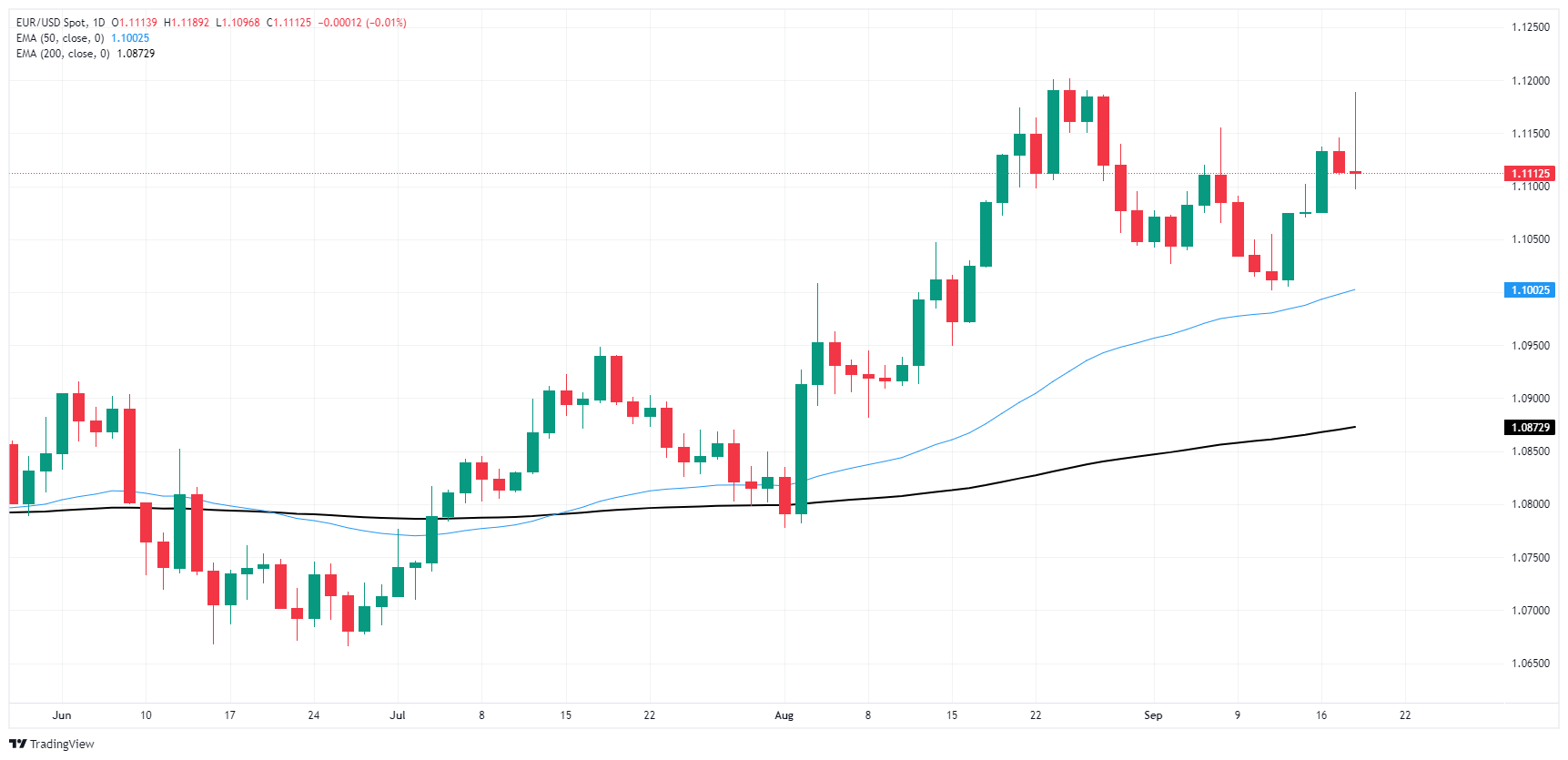- EUR/USD climbed on reaction to first Fed rate cut since March of 2020.
- Fed delivers a surprise 50 bps rate cut out of the gate.
- Fed dot plot eases lower in September, unemployment forecast ticks slightly higher.
EUR/USD soared into a fresh high for September after the Federal Reserve (Fed) surprised markets with a full 50 bps rate cut on Wednesday, pushing risk appetite into the high side and sending traders scrambling for the buy button. This marks the first Fed rate cut in over four years. Following the Fed’s first rate cut since 2020, markets eased back to where they began, with Fiber settling back into the 1.1100 handle.
The Fed’s dot plot of the Federal Open Market Committee’s (FOMC) Summary of Economic Projections was also revised downward from the central bank’s previous rate outlook. The median policy expectations from the Fed now see the Fed Funds rate at 4.4% by year-end 2024 and 3.4% by year-end 2025, down from 5.1% and 4.1%, respectively.
Going deeper into the Fed’s notes, Fed policymakers now see US Gross Domestic Product (GDP) growth of 2.0% flat through 2024, down from the previous print of 2.1% in June. Fed officials also expected the US Unemployment Rate to settle around 4.4% by the end of 2024.
Fed Chair Jerome Powell did his best to soothe markets during his ensuing press conference following the Fed’s bumper 50 bps rate trim, highlighting that the Fed will resume its wait-and-see approach to incoming economic data in the weeks to come before deciding on further rate cuts. The Fed head’s measured approach to explaining the Fed’s policy adjustment helped to keep market flows on-balance, and rate markets are pricing in 65% chance of no further action at the FOMC’s next rate call on November 7.
EUR/USD price forecast
Despite Wednesday’s Fed-fueled intraday rally, EUR/USD continues to churn near the 1.1100 handle. The post-Fed rally toward 1.1200 reversed course in short order, and Fiber has chalked in a flat day for the midweek session. The pair is still cycling chart paper on the high end of recent momentum, and short pressure will have a difficult time staging a full pullback to the 50-day Exponential Moving Average (EMA) near 1.1000.
EUR/USD daily chart
Fed FAQs
Monetary policy in the US is shaped by the Federal Reserve (Fed). The Fed has two mandates: to achieve price stability and foster full employment. Its primary tool to achieve these goals is by adjusting interest rates. When prices are rising too quickly and inflation is above the Fed’s 2% target, it raises interest rates, increasing borrowing costs throughout the economy. This results in a stronger US Dollar (USD) as it makes the US a more attractive place for international investors to park their money. When inflation falls below 2% or the Unemployment Rate is too high, the Fed may lower interest rates to encourage borrowing, which weighs on the Greenback.
The Federal Reserve (Fed) holds eight policy meetings a year, where the Federal Open Market Committee (FOMC) assesses economic conditions and makes monetary policy decisions. The FOMC is attended by twelve Fed officials – the seven members of the Board of Governors, the president of the Federal Reserve Bank of New York, and four of the remaining eleven regional Reserve Bank presidents, who serve one-year terms on a rotating basis.
In extreme situations, the Federal Reserve may resort to a policy named Quantitative Easing (QE). QE is the process by which the Fed substantially increases the flow of credit in a stuck financial system. It is a non-standard policy measure used during crises or when inflation is extremely low. It was the Fed’s weapon of choice during the Great Financial Crisis in 2008. It involves the Fed printing more Dollars and using them to buy high grade bonds from financial institutions. QE usually weakens the US Dollar.
Quantitative tightening (QT) is the reverse process of QE, whereby the Federal Reserve stops buying bonds from financial institutions and does not reinvest the principal from the bonds it holds maturing, to purchase new bonds. It is usually positive for the value of the US Dollar.
